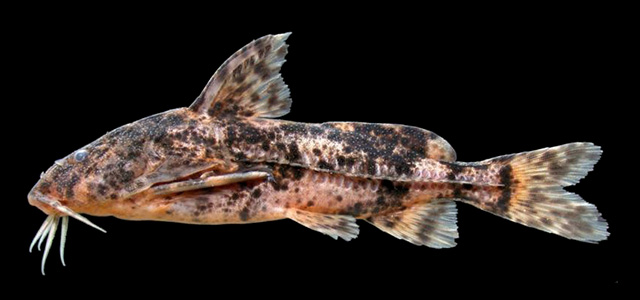| Doradidae (Thorny catfishes), subfamily: Doradinae |
| 9.62 cm SL (male/unsexed) |
|
demersal; freshwater |
| South America: Takutu River (including its tributary, Ireng) that drains into the upper Rio Branco (Amazonas basin), Guyana and Brazil, and the Rupununi River (Essequibo basin) in Guyana. |
|
Dorsal spines (total): 1-1; Dorsal soft rays (total): 6-6. Differs from all nominal species of the genus Rhinodoras by the following combination of characters: heavy pigmentation on ventral surfaces with many dark speckles or larger spots on belly usually extending onto gular region; anterior midlateral plates moderately deep, depth fifth plate 26.3-29% of corresponding body depth; depths of dorsal and ventral wings of anterior plates subequal, depth of dorsal wing slightly less than twice that of ventral; midlateral plates 57-60, midlateral plates anterior to vertical through pelvic fin origin usually five; tympanal portion of lateral-line canal moderately ossified with two or three distinct plates, posterior-most largest with low medial ridge or thorn and moderately developed wings with serrated margins; postcleithral process moderately short and broad, depth 36.8-44.3% of length; adipose eyelid moderate to large, horizontal diameter 11.4-14.2% of HL; pectoral fin usually I,8; and gas bladder one-part with terminal diverticula small and fused. This fish most closely resembles Rhinodoras boehlkei and can be differentiated from this by the following features: heavy pigmentation with many dark speckles or spots on ventral surfaces more elongated postcleithral process, depth 36.8-44.3%; larger adipose eyelid, horizontal diameter 11.4-14.2%; and midlateral plates 57-60 (Ref. 75166).
Description: Dorsal fin I,6; Anal fin iii-iv,8-10; Pectoral fin I,7-8; Pelvic i6 (Ref. 75166). |
| There were individuals encountered during the day hiding in cavities in lateritic boulders submerged in less than three meters of water. An adult specimen was observed at night in a swift shallow run over bedrock (Ref. 75166). |
|
Not Evaluated (N.E.) Ref. (130435)
|
| harmless |
|
Known from Takutu River (including its tributary, Ireng) that drains into the upper Rio Branco (Amazonas basin), and the Rupununi River (Essequibo basin) in southwestern Guyana. In the Takutu River, this fish was observed during the day hiding in cavities in lateritic boulders submerged in less than 3 meters of water while in the Rupununi River, an adult was encountered at night in a swift shallow run over bedrock (Ref. 75166). |
Source and more info: www.fishbase.org. For personal, classroom, and other internal use only. Not for publication.

